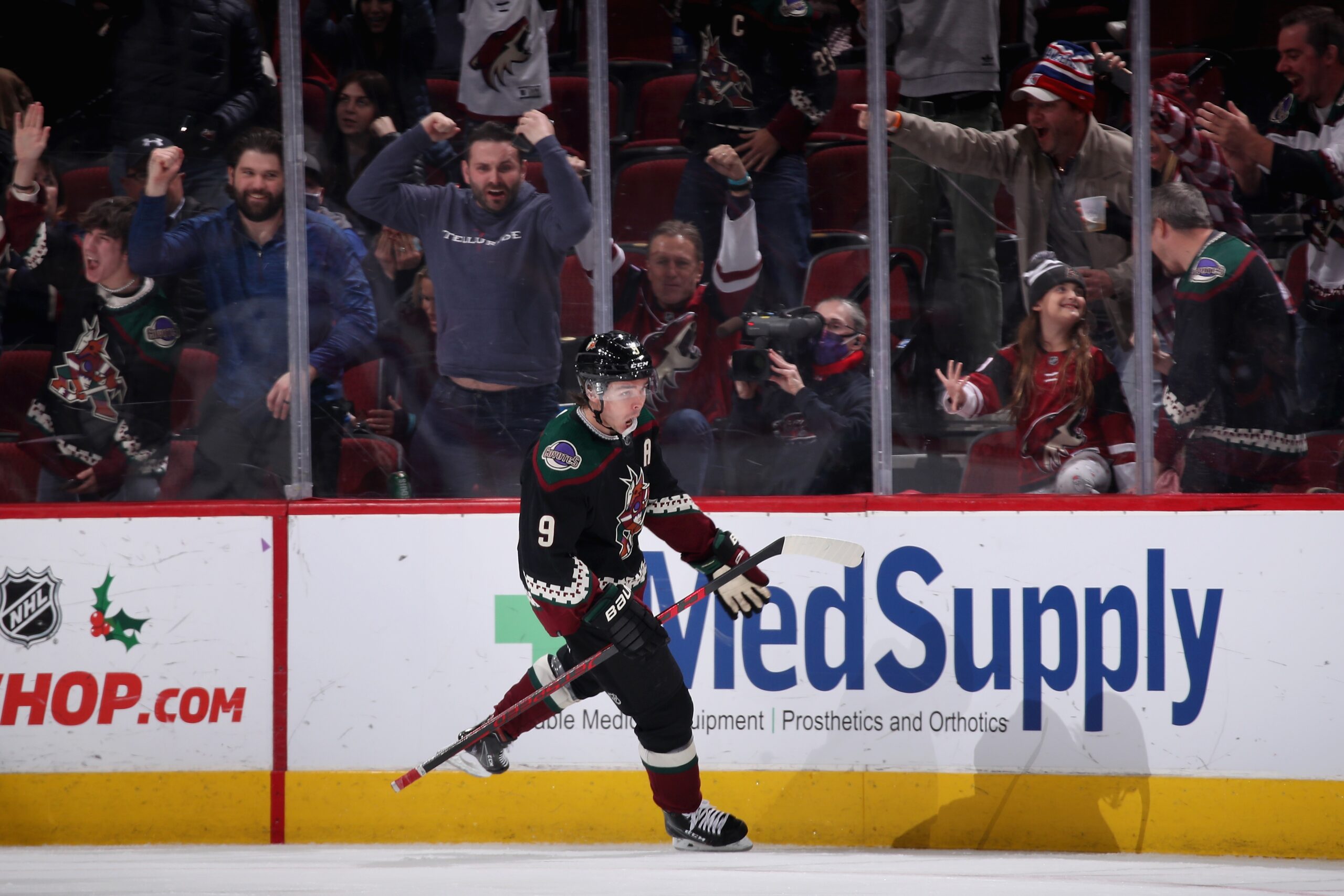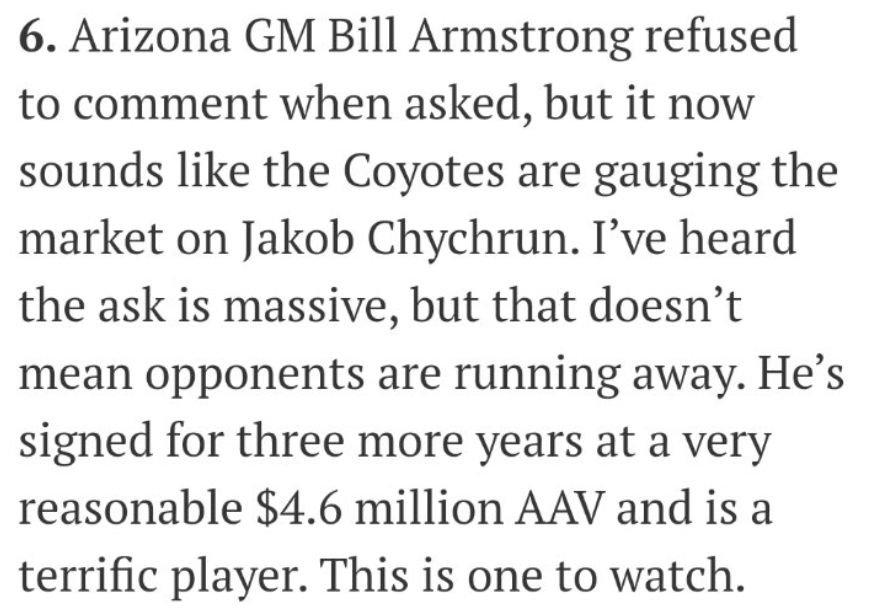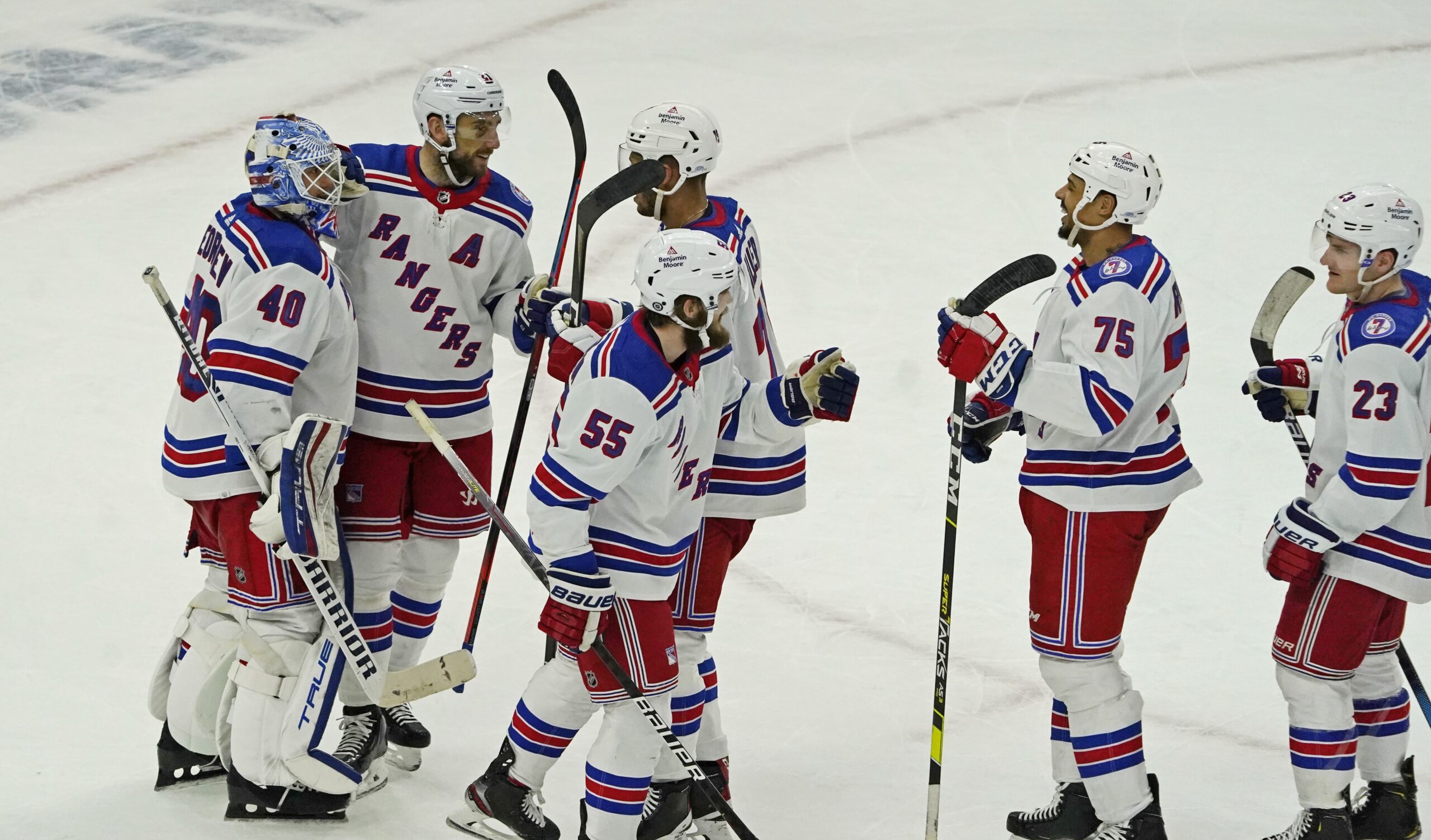© 2025 ALLCITY Network Inc.
All rights reserved.

Little about this Coyotes season has been easy to swallow, but a 3-2 loss to the New York Rangers left the worst taste yet.
The Coyotes were good in their own way at Gila River Arena on Wednesday. They skated with one of the league’s top teams, they out-chanced them 21 to 15, they outplayed them at 5-on-5 and they should have come away with a win, despite their chronic inability to finish.
That possibility even looked probable when Clayton Keller took a feed from Nick Schmaltz, put a deft move on Ranger goalie Keith Kincaid, and tucked the puck inside the far post for a 2-1 lead with 11:13 remaining in regulation.
But a questionable interference call on Phil Kessel gave the Rangers a power play and Mika Zibanejad cashed in. Then a questionable too many men on the ice penalty gave the Rangers another power play and Kaapo Kakko cashed in. Two goals in the final 5:46 of play on two calls that probably shouldn’t have been made.
When asked what he thought of those pivotal calls, Coyotes coach André Tourigny gave an expectedly evasive answer to avoid the league’s wrath.
“Probably the same thing as you,” he said. “Give them credit. Their best players made a difference in those situations. At the same time, I think it’s frustrating on our side because it’s three games in a row we have more scoring chances than our opponent and we cannot find a way to get a point in those three games.
“The Rangers are a pretty good team. They’re at the top of the standings in the Eastern Conference and we had more scoring chances, more quality scoring chances, more shots from the slot, more plays through the slot. We did a lot of good things tonight.”
Even so, the Coyotes have lost six straight games and eight of their past nine, with the only win coming in that miraculous 1-0 shutout in Winnipeg in which Karel Vejmelka made 46 saves. Whatever shred of confidence the team had acquired in the middle of November has evaporated in a litany of injuries and another string of losses, despite better play in all three zones.
Tourigny said the Coyotes will have center Johan Larsson back for a three-game road trip to Pacific Division leader Anaheim, Vancouver, which has won five straight, and Seattle, but the team is still without center Jay Beagle, forward Ryan Dzingel and defenseman Jakob Chychrun, and it lost Christian Fischer in the first period to an upper-body injury when he blocked a shot.
“Tomorrow, the sun will come up but for tonight, we’re not in the best place mentally,” Tourigny said.
Here are five takeaways from Wednesday.

Keller’s consistency
Through Clayton Keller’s five-season career, the challenge has been consistency. He’d produce torrid stretches that made you think he had arrived as an elite NHL player, only to backslide into unproductive stretches where he seemed to vanish from view.
More than a few analysts wondered if that was happening again when Keller had off nights in back-to-back games against the Panthers and Flyers in which he had no points, was a minus-four and had poor possession stats.
It is still a little early to say that Keller has finally turned this pivotal corner, but the performance he turned in on Wednesday was another hint that NHL maturity may have arrived.
Keller had a goal and an assist. Those are the obvious stats, but he also had a team-high eight shots on goal, he logged a forward-high 22:10 of ice time (topped only by defenseman Shayne Gostisbehere) and he had the top expected goals mark in the game.
“His competitiveness every day is beautiful. It’s fantastic,” Tourigny said. “You see him compete, play center, play every second shift, play PK, play power play, play against the best. He works hard on tracking. He works hard in D-zone.
“You want your best player to play like that, to be a model. He does all of it.”
Keller noted previously that he put on seven pounds in the offseason. The added strength has clearly helped him attack the hard areas with more regularity, but he is also dialed into another key to his game.
“The biggest thing I’ve figured out is when I’m skating that’s when I’m at best and I’m not just looking to pass all the time,” he said. “I’m using my feet first and then everything else kind of takes care of itself.”
With two points on Wednesday, Keller is in sole possession of the team points lead with 19. He also leads the team with seven goals. The stats would likely be better on a more talented team, but the Coyotes will need Keller to keep producing offense in whatever form it comes. That was the inescapable truth when they awarded him with that eight-year, $57.2-million contract.

Those Chychrun rumors
Rumors of a Jakob Chychrun trade have been swirling ever since outlets reported that the Islanders had inquired about the Coyotes defenseman this summer. Sportsnet’s Elliotte Friedman stoked those fires in his 32 Thoughts column on Wednesday.

There is an important distinction to be made between gauging the market for a player and listening to offers. The former implies that a team is actively shopping the player. The latter means that the team is listening to offers, and that is something that every GM does in the course of daily business. A GM who isn’t open to all options when trying to accomplish his goals and improve his team is a GM who shouldn’t hold his post.
So are the Coyotes gauging or listening? Armstrong would not comment on the Chychrun rumors, but my sense is that the Coyotes are listening. Unfortunately for Armstrong, he probably has had to listen a lot. When a report such as the Islanders report surfaces, every GM in the league must do his diligence and call to inquire about a young, talented, cost-effective player who is rumored to be available.
Chychrun isn’t having anything close to the season that he had last year. In 2020-21, he was a legitimate Norris Trophy candidate when he topped all defensemen with 18 goals while finishing with 41 points (in a 56-game season). This season, he has two goals and seven points in 26 games, and he is a league-worst minus-29, putting him on pace to set an NHL record in that category. He is currently on injured reserve (retroactive to a game against Florida on Dec. 10) and will not play in Friday’s game against Anaheim, per Tourigny.
There are multiple factors to consider here. First, as Friedman noted, the price for Chychrun would still be astronomical, a sign of how much the Coyotes still value him despite his rough start this season. Chychrun is on a team-friendly contract with a cap hit of $4.6 million for three more seasons after this one.
When the Coyotes embarked upon a full-fledged rebuild in the offseason, Chychrun was thought to be one of a handful of players whose future in Arizona seemed secure. As the reality of this rebuild played out on the ice, however, I have started to wonder (I have mentioned this on a couple of shows) if any of the players from the middle core (Chychrun, Clayton Keller, Nick Schmaltz, Lawson Crouse, Christian Fischer) would be here when the Coyotes came out the other side of it.
It’s hard to endure this for any player, but for those veterans who were acquired on one- or two-year deals, they are nearing the end of their run anyway. For the younger players, the simple opportunity of being in the NHL can counterbalance that suffering. For the middle core of players, they are essentially forfeiting two to three seasons of their prime without hope of playoff contention. That can wear on players’ psyches and impact their game. You can already argue that the lack of talent around him, and being thrust into the No. 1 defenseman role at age 23 with no legitimate top-pairing partner has already impacted Chychrun’s game.
I have been approached by three NHL sources in the past two weeks, who told me that they had heard a rumor that the Chychruns and Jakob’s agent, Andrew Scott, have requested a trade. I don’t think that is accurate, and if you know the family, you’d find that rumor difficult to believe. That said, Armstrong might be doing Chychrun and those other middle-core players a favor by moving them to another team where they have a better chance at success in the next few seasons. If Armstrong does move Chychrun – and again, he is not actively shopping him – the return would have to be huge, and it would have to include more than draft picks.

Rebuild reminder
It was almost four years ago when the Rangers publicly announced their intention to rebuild in a letter to fans from team executive Glen Sather and then-GM Jeff Gorton. When the Rangers left Gila River Arena on Wednesday, they were one point off the NHL lead and owned the fourth-best points percentage (.707).
There are still questions about New York’s center depth, and as a former colleague repeatedly noted, progress isn’t always linear. This season’s meteoric rise from non-playoff team to apparent contender should be sprinkled with those analytical grains of salt, but the Rangers are still an example of what is possible when a team acquires a boatload of assets and then executes on them.
New York probably was never as bad or barren as the current Coyotes are, so that should also be remembered when eyeing the Coyotes’ future, but there is often this notion floated that it could take seven, eight, even 10 years for the Coyotes to climb back into the picture. Sometimes, it takes that long to build a Stanley Cup winner (it did in Chicago), but if your team is making the playoffs after a few seasons of rebuilding, that is probably an acceptable sign of progress – especially in a market such as Arizona where the Coyotes have only qualified for the playoffs four times in the past 18 seasons.
As has been mentioned numerous times, the Coyotes have eight picks in the first two rounds of the 2021 NHL Draft and they already have Dylan Guenther in the pipeline. It won’t show on the ice next season, but this summer could have a major impact on the Coyotes’ future.
“It’s an exciting time for us,” Armstrong said. “It’s an opportunity for us to move our club forward with a lot of players.”

Moser debuts
Janis Moser made his NHL debut against the Rangers on Wednesday, making him the fifth Coyote to make his NHL debut this season (Karel Vejmelka, Dysin Mayo, Cam Dineen, Ben McCartney).
The Coyotes selected Moser in the second round (No. 60) of the 2021 NHL Draft, but scouts had been keyed into him for a long time, fueling reports that the Coyotes were eyeing him. The European scout who first keyed GM Bill Armstrong into Moser should be familiar to Coyotes fans. It was Teal Fowler, the same guy who convinced them to take a flier on goalie Karel Vejmelka.
“He did the legwork and he was a driving force with that guy so let’s get that straight,” Armstrong said of Fowler. “Our scouts said, ‘Listen, there’s a guy that we probably should have taken that was hanging around the draft and he just keeps getting better and better. So we were aware of him the year before.
“We were able to come to terms with the agent and his club over there about letting them go, so that was a bonus for us; the fact that we could draft somebody, bring him in and start developing him right away with our American league team the year after the draft.”
Moser has enjoyed a rapid ascent from a player that was mildly interesting to one in whom the Coyotes had second-round interest. It’s probably not fair to call him a late bloomer at age 21, but his NHL potential became clear a couple years after most players typically display that ability.
“From the get go, that kid came in on his first day on the ice, and I remember watching him and thinking, ‘Oh, my God, he’s pushing that group. He’s come here to make our club.’ He just didn’t come in, like, ‘I’m gonna tiptoe around these NHL guys.’
“He’s still got lots of room to grow, but there’s some good signs and with the amount of injuries and the lack of depth that we have this year, due to the structure of our team, he’s getting an opportunity and well deserved. He’s been our best defenseman in the American league from start to finish. And with the bonus of his work ethic, he drives that group. He’s the hardest working player and he has produced the most success on the backside right now.”
Moser said he had numerous messages from his native country of Switzerland, whether from old teammates, family or friends. Many of them were watching his debut.
“When you start hockey at five years old you dream about that one moment when you play your first NHL game,” he said. “Before the game, you think about how it’s going to be and this and that. Once it starts, it’s a hockey game and you don’t have time to think about all the things that are going on so you just focus on what you have to do; focus on your job.”

Spanish broadcasts
In their increasing efforts to widen their fan base to a largely untapped Spanish-speaking market, the Coyotes announced a partnership with Univision Arizona to broadcast a Coyotes game of the week on radio in Spanish. As part of the agreement, KHOV 105.1 FM will broadcast 14 Coyotes games during the remainder of the 2021-22 NHL season, beginning with the Coyotes-Tampa Bay game on Dec. 23.
“To expand our rabid fan base, we need to attract Latinos to our great sport and expose hockey to new communities,” team president and CEO Xavier Gutierrez said in a news release. “We also need to super-serve our Latino fans and fans in waiting. Our Spanish radio Game of the Week broadcast with Univision Arizona will help us engage with the Valley’s Hispanic market in an authentic way and promote growth, diversity and inclusion.”
Cardinals Spanish play-by-play announcer Luis Hernandez will call all of the games on KHOV 105.1 FM. Hernandez has worked for the Cardinals since 1998 in a variety of on-air and content creation roles. Last season was his first as their play-by-play man for Spanish broadcasts, but he produced this memorable call on Kyler Murray’s Hail Mary touchdown pass to DeAndre Hopkins to beat the Bills at State Farm Stadium.
Here is the isolated audio clip, courtesy of the Cardinals.
“It’s so important for the Hispanic community to feel that somebody cares,” Hernandez said. “I am going to be like a gate between the Coyotes and this community. It’s a huge opportunity.”
While Hernandez said he has watched hockey on television, he attended his first live game this season when the Coyotes played the Ducks in the preseason. The game came shortly after the Coyotes had contacted him about the possibility of doing Spanish broadcasts.
“I’m from Mexico City and we don’t watch hockey in Mexico at all, so to learn it is really hard,” said Hernandez, who earned his degree in journalism and always dreamed of doing play-by-play. “But there’s a connection between hockey and soccer. There’s differences, but a lot of similarities in the way the game is played.”
Hernandez has been studying like mad to prepare for his first game, which will come solo (like all of them) in the booth. He will not have an analyst sitting next to him.
“The hardest part for me has been learning how to pronounce the last name of the players correctly,” he said, laughing (he’s not alone). “It’s going to be a dream for me to call goals like in soccer. I’ve been practicing a couple of calls. I’m going to say it three times, ‘goal, goal, goal.’ And then I’m going to try, ‘How the Coyote howls,’ but of course I’m going to say it in Spanish. It will be a combination of things.
“It won’t matter if we’re losing six to nothing with four minutes left in the third period. If we score a goal, I’m going to call it like crazy. I’m going to make it fun.”
Here is the Coyotes’ complete Spanish radio broadcast schedule:
Dec. 23: Coyotes vs. Tampa Bay, 7 p.m.
Jan. 4: Coyotes vs. Winnipeg, 7 p.m.
Jan. 12: Coyotes vs. Toronto, 8 p.m.
Jan. 28: Coyotes vs. Boston, 7 p.m.
Feb. 2: Coyotes vs. Calgary, 7:30 p.m.
Feb. 23: Coyotes vs. Los Angeles, 8 p.m.
Mar. 3: Coyotes vs. Colorado, 7 p.m.
Mar. 19: Coyotes vs. Pittsburgh, 2 p.m.
Mar. 23: Coyotes vs. Seattle, 7 p.m.
Mar. 30: Coyotes vs. San Jose, 7 p.m.
Apr. 7: Coyotes vs. Vancouver, 7 p.m.
Apr. 12: Coyotes vs. New Jersey, 7 p.m.
Apr. 20: Coyotes vs. Chicago, 7 p.m.
Apr. 29: Coyotes vs. Nashville, 7:30 p.m.
Follow Craig Morgan on Twitter
Comments
Share your thoughts
Join the conversation



